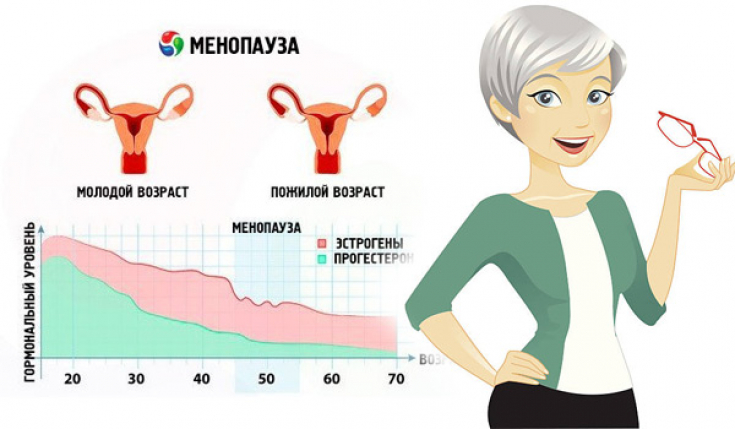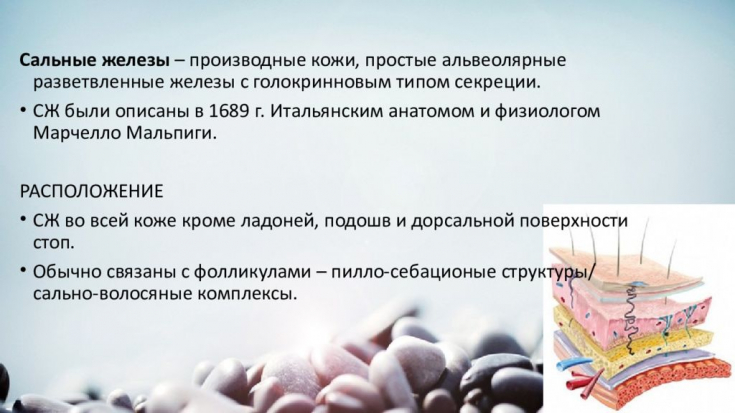Diseases of the sebaceous glands are registered in 70-80% of the adult population, occupying the first place in the structure of cosmetic pathology and the third − according to the frequency of visits to dermatological institutions, they are characterized by a tendency to a chronic course with frequent relapses, progradient and refractoriness of conventional therapy.
This is why it is so important to know about the impact of menopausal hormonal changes on the condition of the sebaceous glands.
Find out in the article estet-portal.com what features of changes in the state of the sebaceous glands in women during menopause.
Relevance of the issue of changes in the condition of the skin during menopause
Literature data show that only 10% of all dermatological patients are patients over 25 years old with diagnosed seborrhea and acne in the form of acne adultorum, the other part of patients are older women. 5% of women and 3% of men between the ages of 40 and 49 have clinical manifestations of acne, which occurs at this age (acne tarda), acne can also be observed at the age of 60.
Follow us on Instagram!
For the first time in women with diseases of the sebaceous glands in the period of perimenopause, a comprehensive examination was carried out: the endocrine status based on the study of the level of sex steroid hormones (estradiol, progesterone, testosterone), gonadotropic hormones (FSH, LH) and thyroid hormones (TSH) in the blood serum , T3, T4).
Involuntary Urination: Causes of an Embarrassing Problem
Along with conventional laboratory tests (complete blood count, general urinalysis, fecal test for helminth eggs, blood test for glucose levels), the content of gonadotropic hormones (lutropin (LH), folitropin (FSH)), thyroid-stimulating hormone was determined in the blood serum (TSH), prolactin (PRL) & minus; enzyme immunoassay). Levels of sex steroid hormones (estradiol, progesterone and testosterone), and levels of thyroid hormones (triiodothyronine (T3), thyroxine (T4)) - by radioimmune method.
Procedure for conducting a study of menopausal women
Manifestations of pathological menopause were observed in all examined women in the form of a climacteric syndrome. The assignment of patients to the perimenopausal period was carried out jointly with the gynecologist-endocrinologist on the basis of established menopausal complaints, menstrual irregularities, analysis of ultrasound of the pelvic organs with the determination of the state of the endometrium, and assessment of the state of the ovarian follicular apparatus. The diagnosis of menopausal syndrome was also made together with a gynecologist-endocrinologist using the Kupperman index.

The subjects were consulted by a general practitioner, gastroenterologist, gynecologist-endocrinologist, mammologist, neuropsychiatrist in order to identify and treat comorbidities.
The most common symptoms are those of the climacteric syndrome − VSD (81.3%), asthenoneurotic syndrome (50.0%), neuroses (56.3%), and diseases of the gastrointestinal tract.
Changes in the condition of the sebaceous glands during menopause
After the study, it was found that most of the patients received traditional complex therapy for diseases of the sebaceous glands, which corresponded to the accepted standard of treatment and was ineffective.
Among all women, only 14.6% did not seek help.
At menopausal age, the change in the function of the sebaceous glands occurs not only in the direction of reducing the secretory activity of the latter, determining one of the reasons for the formation of excessive dryness of the skin (due to secondary hypofunction of the sebaceous glands), but also in the direction of increasing, which leads, in particular, to development of seborrhea and its complications (various forms of acne).

At the same time, after 35-40 years, women develop excessive dryness of the skin. In 38% of women, the latter occurs after the age of 35, in 77% of cases - in patients over 64 years of age and in 100% - after 80 years.
Endocrine disorders occupy a significant place in the etiopathogenesis of the above dermatoses. However, data on the effect of an imbalance of certain hormones on the metabolism of other endogenous factors that also affect the state of the dermis and epidermis are not very informative.
Among women with treatment-resistant forms of acne vulgaris, irregular menstrual cycles are noted in 17.6% of cases, in 15% of cases − amenorrhea.
Metabolic and endocrine disorders in the menopausal period include changes in the function of the thyroid gland, a violation of the structural and functional state of the bone tissue. Diseases of the sebaceous glands in the perimenopause are characterized by a chronic, protracted course, in the vast majority with a disease duration of 36 months or more (51, 7% of patients).
When examining the content of papulopustules for the presence of Demodex folliculorum mite, the latter was found in 20%.
Seborrhea, late acne and excessive dry skin often occur in women in the perimenopausal period - at the age of their most active social and professional activities. This makes it expedient to deeply study the features of the mechanism of development of sebaceous gland diseases in women in the perimenopausal period in order to further improve the methods of prevention and correction of changes associated with a decrease in the level of sex steroid hormones.
Mammography: disappointment in breast examination
What is important in the treatment of sebaceous glands during menopause
- relationship between the pituitary-gonadal system and the pituitary-thyroid gland system;
-the significance of the role of the endocrine sphere and morphological and functional features of the skin in the pathogenesis of uncomplicated seborrhea, late acne and excessive dry skin in women in the perimenopausal period was compared;
"Dry" problem: genitourinary syndrome of menopause
- a comprehensive examination of women with diseases of the sebaceous glands in the perimenopausal period with the inclusion of drugs that correct the hormonal status, and its possible impact was analyzed.
The conducted studies reveal the nature of endocrine disorders and allow to supplement the existing ideas about hormonal imbalance in women with diseases of the sebaceous glands in the perimenopausal period.
How to deal with premenstrual syndrome







Add a comment